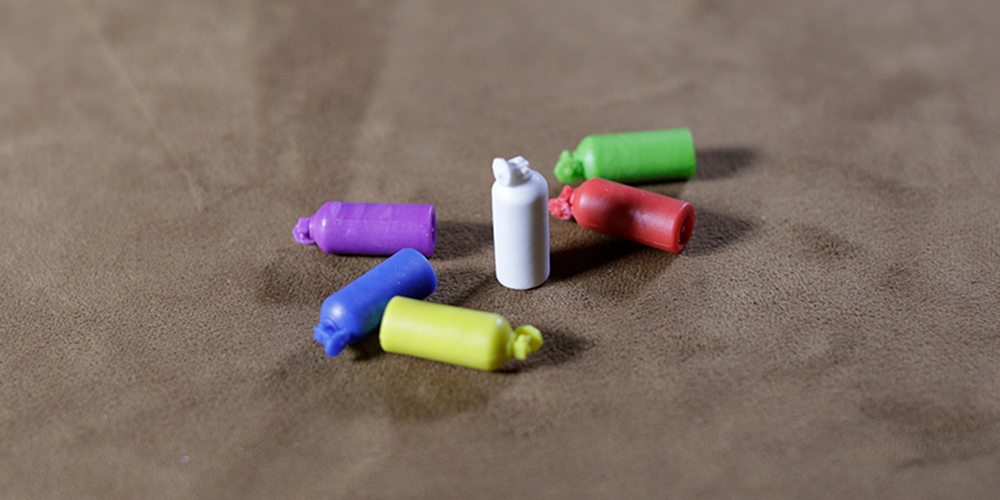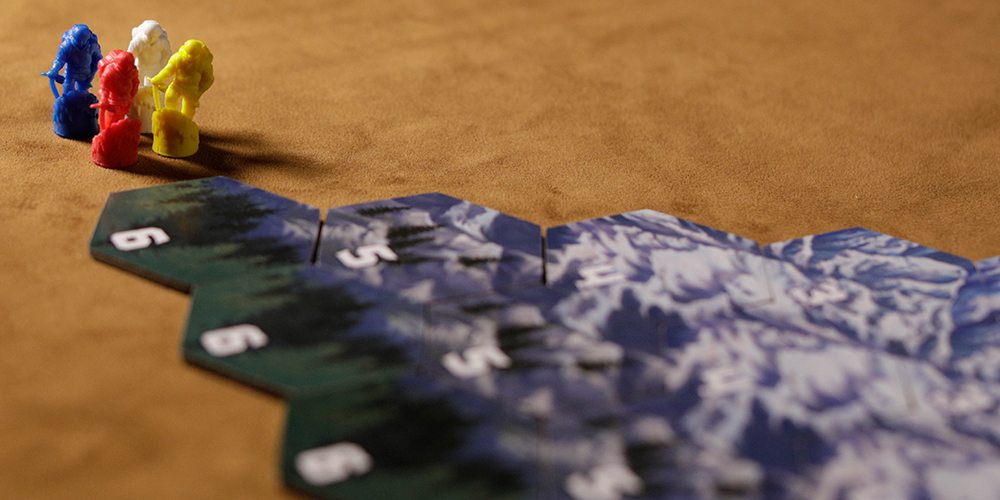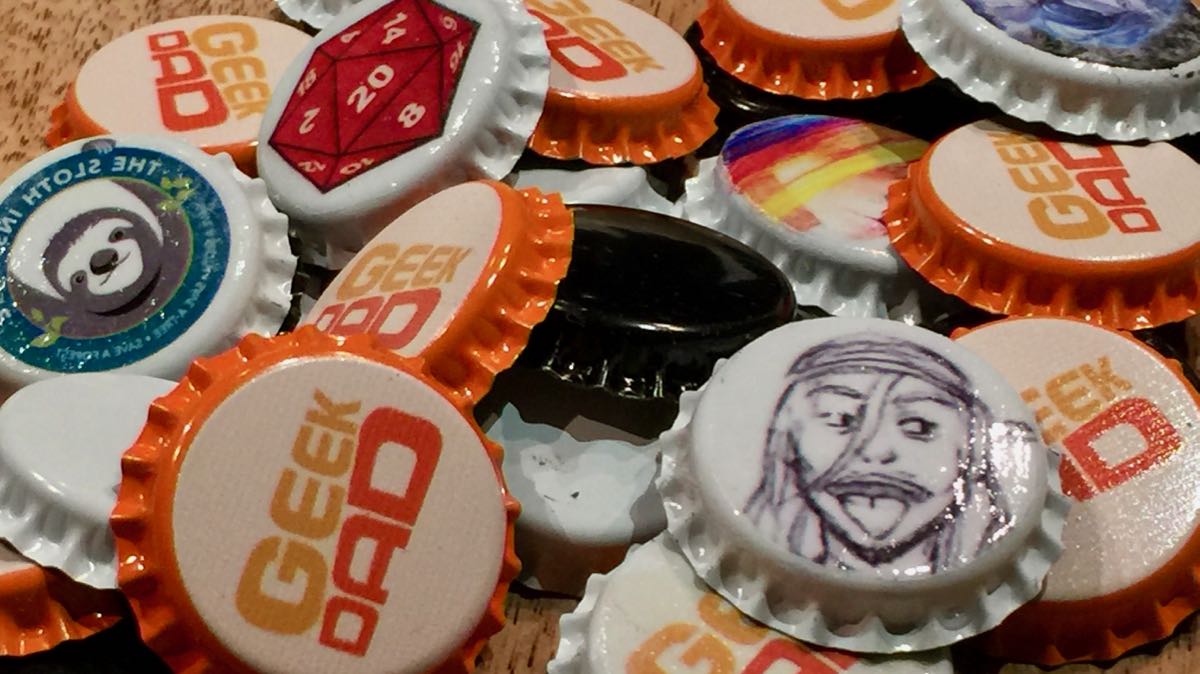
It’s … getting … hard to breathe … up … here …
… is that … a … yeti?
Run!
What is Dicey Peaks?
Dicey Peaks is a press your luck, dice rolling game that has a little exploration to it and is published by Calliope Games. Scott Almes (The Tiny Epic ______ games and Harbour, Best Treehouse Ever) designed the game for 2 to 6 players, ages 8 and up, which plays in about 45 minutes.

Dicey Peaks Components
In the box, you’ll find:
- 6 Climber pawns
- 6 Oxygen marker tokens
- 6 Oxygen game boards
- 29 Mountain hex tiles, divided into five levels (8 Level Six, 7 Level Five, 6 Level Four, 5 Level Three, 3 Summit tiles)
- 13 Frosted dice (4 white, 4 dark blue, 5 light blue)

With the Oxygen markers and the Oxygen game boards, you keep track of the life-giving gas that’s available to you. Too much or too little and you’re unable to move on your turn. The oxygen level also becomes very important on your final push to the summit, but more on that in the How to Play section. Like the Oxygen marker, the Climber pawn is very detailed and made from heavy plastic. Both are nice and feel worthy of a mountain expedition.
The Mountain hex tiles are nicely printed, on luxuriously thick cardboard. On the back side, they have a number designating which level they belong on and the opposite side, a benefit or penalty that will be revealed during play. Six of the level six tiles are placed, 5 of the level five, and so on, meaning two random tiles from each level are removed from the game and placed in the box, making for a unique game each time. At the top, the 3 Summit tiles are randomly placed with two false summits and one winning summit somewhere at the top. When all assembled, the backs look like an actual mountain. It’s a neat outcome.
Finally, there are the dice. They are frosted and somewhat opaque. It ends up being a pretty cool look, like the dice are half frozen. The dice are divided into three colors, white, light blue, and dark blue, and each color has its own unique distribution of icons. The white dice have more pickaxes, for a higher likelihood of climbing, the dark blue have more tents, for a higher likelihood of resting and the light blue have an equal distribution of outcomes.

How to Play Dicey Peaks
Objective
The goal of Dicey Peaks is to be the first player to reach the summit with the flag on it. To do that, you’ll have to roll dice, manage oxygen, and trust in a bit of luck to reach the top first.

A Simple Game with Tough Decisions
On the face of it, Dicey Peaks is, essentially, roll & move. However, there’s so much more to that. Players must decide which dice to roll, whether to climb or rest, manage their oxygen levels, move cautiously up the mountain … all while avoiding a Yeti.
Players begin by choosing five dice to roll. Dice have four different faces: pickaxes, which are used to climb; avalanches, which can cause you to bust when climbing; tents, which allow a climber to rest; and yetis, which will slow you down when climbing, allow others to catch up, and can cause you to bust when resting. The four white dice have three pickaxes and one each of the other faces. The dark blue dice have three tents and one each of the other faces. The light blue dice have two tents, two pickaxes, and one each of the avalanche and yeti faces.
If you plan on climbing, it’s best to take the four white dice and a light blue die to increase your odds of rolling pickaxes. After your first roll, you must decide if you are climbing or resting, based on your first results. If climbing, you must set aside all pickaxes and avalanche dice, as well as any yetis. If climbing, set aside any tents and any yetis. After making your decision and setting dice aside, you may continue to roll by drawing dice from the pool and any dice you did not set aside during your previous roll.

When you are satisfied with your results, announce you are done rolling and take the appropriate climb or rest actions. If climbing, move your oxygen meter down by the number of pickaxes you rolled, then move your climber ahead (always move left to right on every level of the mountain). Then turn over the hex you’ve landed on and perform its action. If the tile had already been turned, just perform the action on the tile you stopped on. If the action moves you forward or back, you just move. In this case, you don’t flip a tile or perform a second action.
If you are resting, move the oxygen tank up one spot on your oxygen meter for each tent you rolled. It’s important to note that you may never earn more oxygen than the level of the mountain you are on. For example, on level three of the mountain, you may only increase your oxygen meter up to three spots, depending on your roll. It is impossible to rest when on the summit tiles.

Mountain Climbing Is Fraught with Peril
It is possible to bust when rolling dice. If you are climbing and you accumulate three avalanche dice, you bust and lose your progress for that turn. You can also bust when climbing by accumulating more pickaxes than the oxygen you have available on your oxygen meter.
When resting, you can bust by accumulating three yeti symbols. You can also bust if you earn enough tent-sided dice that it would push you above the maximum level on the oxygen meter.
Further, no matter if you are climbing or resting, if you roll a yeti on your turn, all climbers behind you are allowed to move forward one space without spending any oxygen. These climbers don’t flip tiles or perform actions on their new tiles. Climbers ahead of you (or on the same tile) are not affected.

Reaching the Summit
As you climb higher on the mountain, tiles are more likely to provide punishment, slips back downhill or loss of oxygen. It’s a challenge. On top of that, your strategy for resting becomes more important. With oxygen loss on tiles and movement, sucking away your O2, you must really plan your summit strategy well.
Just one of the three tiles at the peak is the winning tile. The other two are false summits. The real issue is, once you begin your summit drive, you can neither rest above level 3, nor return to a safe altitude to recover oxygen. What you summit with is all you are going to have.
As if that wasn’t tough enough, even though you may only be moving a single tile in movement, you must lose one oxygen for every single pickaxe rolled. Busting rules still apply. If you don’t find the flag, you remain on the turned tile and hope that you have enough oxygen for a second (or third) discovery. If you run out of oxygen on the summit, it’s game over, man. Find the flag and your accomplishment will be celebrated for all eternity … or at least until you reset the mountain for another game.
Why You Should Play Dicey Peaks
Press your luck games are great. Anyone can play and, unless your luck is consistently horrible, you can typically be competitive in a game without a huge amount of strategic thinking. Dicey Peaks is true to that generality, with some very important exceptions. The yeti dice are a great catch-up mechanism that not only does a good job of keeping everyone relatively close to each other, it’s possible for someone to bust several times at the beginning of the game, yet still win thanks to the yeti. What’s more, the notion of gambling what you’ve earned with great reward and disastrous loss on the line makes the decision to keep rolling ridiculously fun.
We loved the tile layout of the game and all the components, which all really added to the theme of Dicey Peaks. The tiles are really nice and the dice are just gorgeous. What’s more, the climber and oxygen tank tokens are top shelf.
A press your luck game is fun enough on its own, but the oxygen management portion of the game and the commitment each player has to make to climbing or resting adds a challenging element to the game. In Dicey Peaks, at first, everyone starts out care-free, adventurous, and ready to roll and reroll to make plenty of progress up the mountain. But as oxygen dwindles and the altitude thins, strategies tighten up and luck is pressed less and less.
Because press your luck games are so dependent on, well, luck, it’s nice to have one that strategy is so important in. As you prepare to summit, the oxygen you have, the dice you choose, and the tiles you must traverse become incredibly important and adds a healthy dose of stress and anxiety to the game (but in a fun way).
Dicey Peaks is a unique game for both Calliope and Scott Almes; neither have done a game like this before. Nevertheless, the result is a very enjoyable game that will find its place at the table, whether you’re playing with your family or your game group.
Dicey Peaks retails for $29.99 and will be available the first week of November.

Click here to see all our tabletop game reviews.
Disclosure: GeekDad received a copy of this game for review purposes.




